Analysis of Leadership Change and Management in the NHS: Report
VerifiedAdded on 2022/12/16
|14
|4345
|360
Report
AI Summary
This report provides an in-depth analysis of leadership and organisational change within the National Health Service (NHS). It examines the government's interventions, including the replacement of Primary Care Trusts with Clinical Commissioning Groups, and investigates the causes of these changes, such as technological advancements, social and political shifts, and managerial personnel changes. The report explores the social and organisational consequences of these changes, including impacts on stakeholders and the status of General Practices. It offers recommendations for leading and managing organisational change, emphasizing the importance of clear vision, stakeholder connection, transparency, and accountability. The report also reflects on specific leadership styles, their relation to employee engagement, and organisational development, concluding with insights into effective change management strategies for the NHS.

Leadership change and
management
management
Paraphrase This Document
Need a fresh take? Get an instant paraphrase of this document with our AI Paraphraser
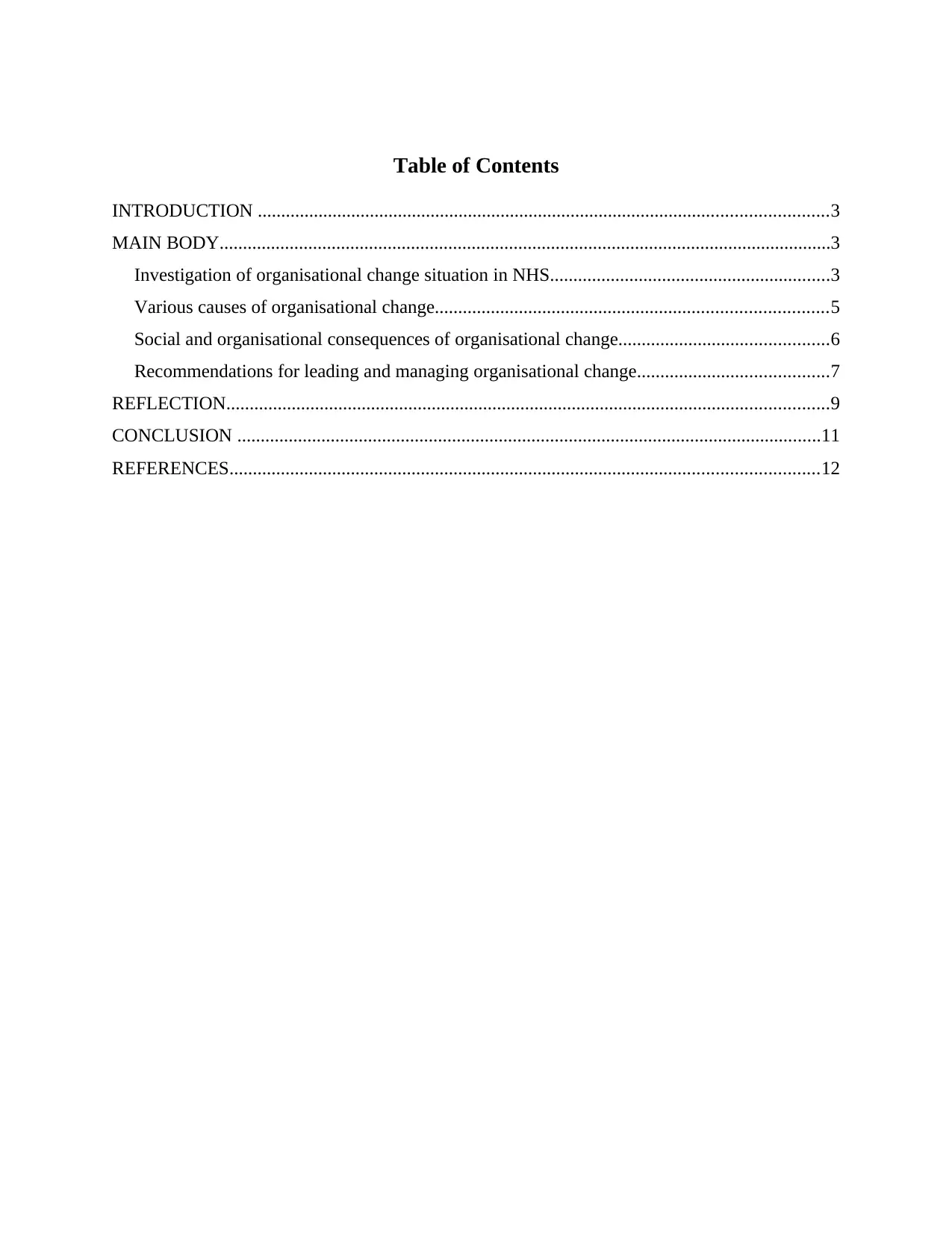
Table of Contents
INTRODUCTION ..........................................................................................................................3
MAIN BODY...................................................................................................................................3
Investigation of organisational change situation in NHS............................................................3
Various causes of organisational change....................................................................................5
Social and organisational consequences of organisational change.............................................6
Recommendations for leading and managing organisational change.........................................7
REFLECTION.................................................................................................................................9
CONCLUSION .............................................................................................................................11
REFERENCES..............................................................................................................................12
INTRODUCTION ..........................................................................................................................3
MAIN BODY...................................................................................................................................3
Investigation of organisational change situation in NHS............................................................3
Various causes of organisational change....................................................................................5
Social and organisational consequences of organisational change.............................................6
Recommendations for leading and managing organisational change.........................................7
REFLECTION.................................................................................................................................9
CONCLUSION .............................................................................................................................11
REFERENCES..............................................................................................................................12
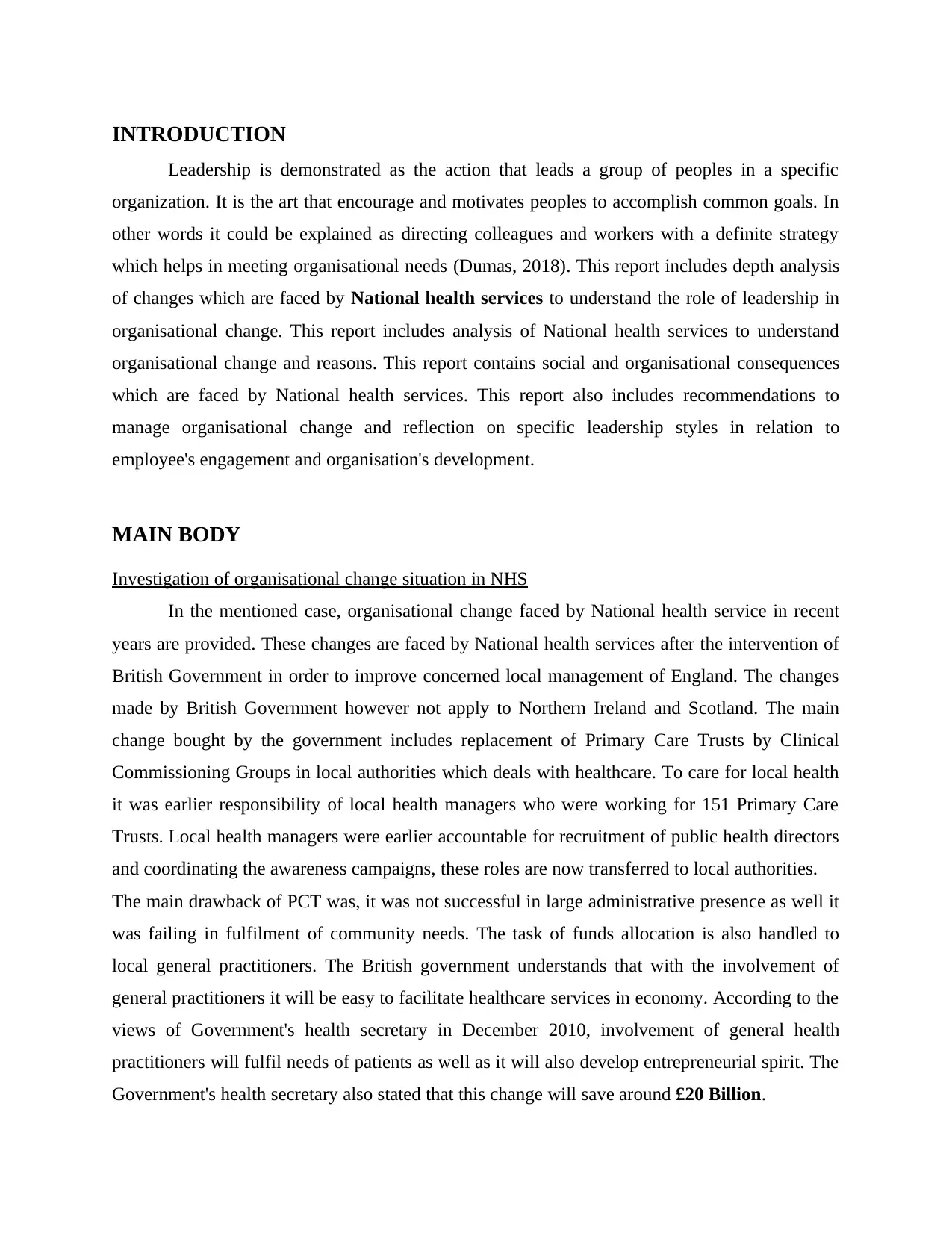
INTRODUCTION
Leadership is demonstrated as the action that leads a group of peoples in a specific
organization. It is the art that encourage and motivates peoples to accomplish common goals. In
other words it could be explained as directing colleagues and workers with a definite strategy
which helps in meeting organisational needs (Dumas, 2018). This report includes depth analysis
of changes which are faced by National health services to understand the role of leadership in
organisational change. This report includes analysis of National health services to understand
organisational change and reasons. This report contains social and organisational consequences
which are faced by National health services. This report also includes recommendations to
manage organisational change and reflection on specific leadership styles in relation to
employee's engagement and organisation's development.
MAIN BODY
Investigation of organisational change situation in NHS
In the mentioned case, organisational change faced by National health service in recent
years are provided. These changes are faced by National health services after the intervention of
British Government in order to improve concerned local management of England. The changes
made by British Government however not apply to Northern Ireland and Scotland. The main
change bought by the government includes replacement of Primary Care Trusts by Clinical
Commissioning Groups in local authorities which deals with healthcare. To care for local health
it was earlier responsibility of local health managers who were working for 151 Primary Care
Trusts. Local health managers were earlier accountable for recruitment of public health directors
and coordinating the awareness campaigns, these roles are now transferred to local authorities.
The main drawback of PCT was, it was not successful in large administrative presence as well it
was failing in fulfilment of community needs. The task of funds allocation is also handled to
local general practitioners. The British government understands that with the involvement of
general practitioners it will be easy to facilitate healthcare services in economy. According to the
views of Government's health secretary in December 2010, involvement of general health
practitioners will fulfil needs of patients as well as it will also develop entrepreneurial spirit. The
Government's health secretary also stated that this change will save around £20 Billion.
Leadership is demonstrated as the action that leads a group of peoples in a specific
organization. It is the art that encourage and motivates peoples to accomplish common goals. In
other words it could be explained as directing colleagues and workers with a definite strategy
which helps in meeting organisational needs (Dumas, 2018). This report includes depth analysis
of changes which are faced by National health services to understand the role of leadership in
organisational change. This report includes analysis of National health services to understand
organisational change and reasons. This report contains social and organisational consequences
which are faced by National health services. This report also includes recommendations to
manage organisational change and reflection on specific leadership styles in relation to
employee's engagement and organisation's development.
MAIN BODY
Investigation of organisational change situation in NHS
In the mentioned case, organisational change faced by National health service in recent
years are provided. These changes are faced by National health services after the intervention of
British Government in order to improve concerned local management of England. The changes
made by British Government however not apply to Northern Ireland and Scotland. The main
change bought by the government includes replacement of Primary Care Trusts by Clinical
Commissioning Groups in local authorities which deals with healthcare. To care for local health
it was earlier responsibility of local health managers who were working for 151 Primary Care
Trusts. Local health managers were earlier accountable for recruitment of public health directors
and coordinating the awareness campaigns, these roles are now transferred to local authorities.
The main drawback of PCT was, it was not successful in large administrative presence as well it
was failing in fulfilment of community needs. The task of funds allocation is also handled to
local general practitioners. The British government understands that with the involvement of
general practitioners it will be easy to facilitate healthcare services in economy. According to the
views of Government's health secretary in December 2010, involvement of general health
practitioners will fulfil needs of patients as well as it will also develop entrepreneurial spirit. The
Government's health secretary also stated that this change will save around £20 Billion.
⊘ This is a preview!⊘
Do you want full access?
Subscribe today to unlock all pages.

Trusted by 1+ million students worldwide
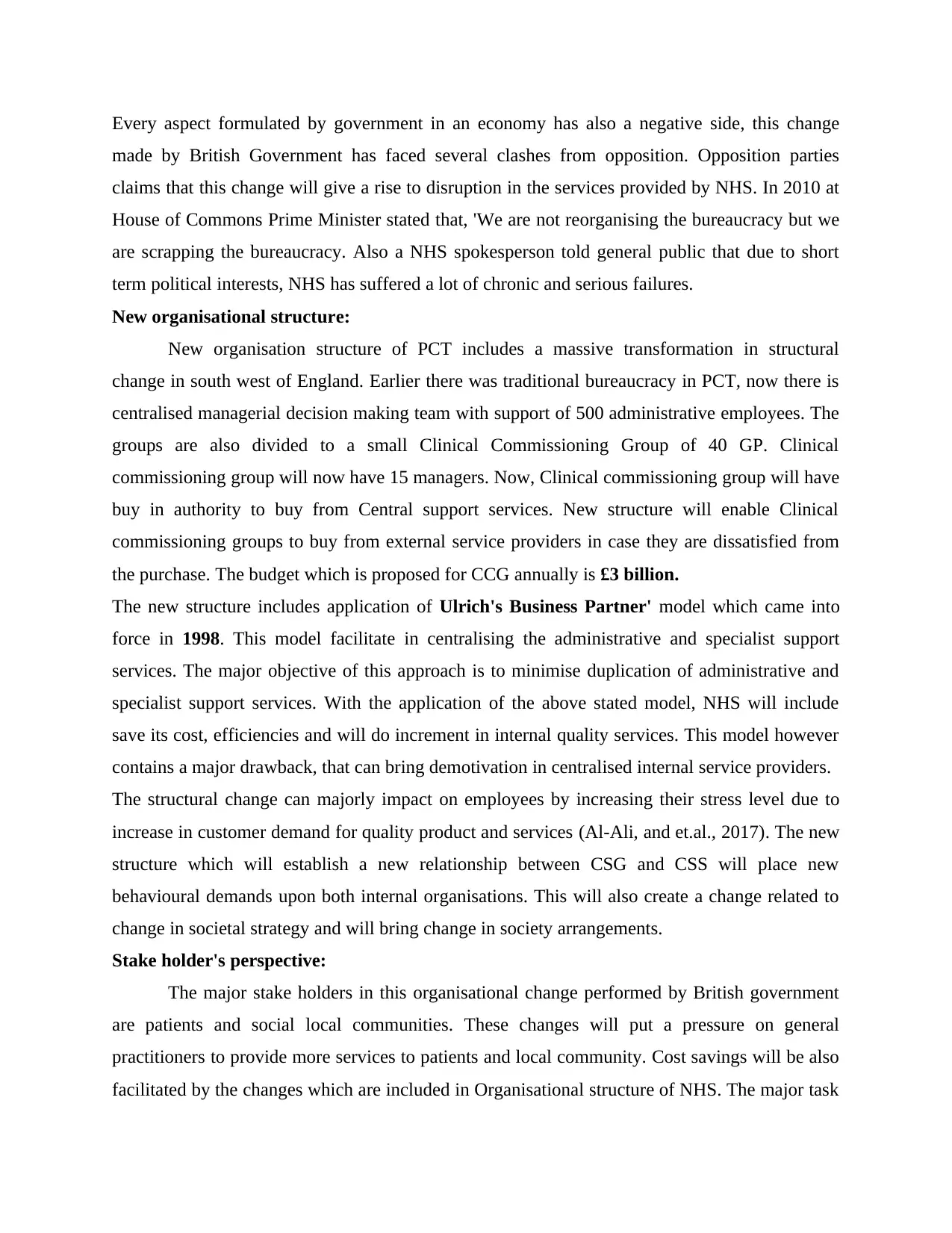
Every aspect formulated by government in an economy has also a negative side, this change
made by British Government has faced several clashes from opposition. Opposition parties
claims that this change will give a rise to disruption in the services provided by NHS. In 2010 at
House of Commons Prime Minister stated that, 'We are not reorganising the bureaucracy but we
are scrapping the bureaucracy. Also a NHS spokesperson told general public that due to short
term political interests, NHS has suffered a lot of chronic and serious failures.
New organisational structure:
New organisation structure of PCT includes a massive transformation in structural
change in south west of England. Earlier there was traditional bureaucracy in PCT, now there is
centralised managerial decision making team with support of 500 administrative employees. The
groups are also divided to a small Clinical Commissioning Group of 40 GP. Clinical
commissioning group will now have 15 managers. Now, Clinical commissioning group will have
buy in authority to buy from Central support services. New structure will enable Clinical
commissioning groups to buy from external service providers in case they are dissatisfied from
the purchase. The budget which is proposed for CCG annually is £3 billion.
The new structure includes application of Ulrich's Business Partner' model which came into
force in 1998. This model facilitate in centralising the administrative and specialist support
services. The major objective of this approach is to minimise duplication of administrative and
specialist support services. With the application of the above stated model, NHS will include
save its cost, efficiencies and will do increment in internal quality services. This model however
contains a major drawback, that can bring demotivation in centralised internal service providers.
The structural change can majorly impact on employees by increasing their stress level due to
increase in customer demand for quality product and services (Al-Ali, and et.al., 2017). The new
structure which will establish a new relationship between CSG and CSS will place new
behavioural demands upon both internal organisations. This will also create a change related to
change in societal strategy and will bring change in society arrangements.
Stake holder's perspective:
The major stake holders in this organisational change performed by British government
are patients and social local communities. These changes will put a pressure on general
practitioners to provide more services to patients and local community. Cost savings will be also
facilitated by the changes which are included in Organisational structure of NHS. The major task
made by British Government has faced several clashes from opposition. Opposition parties
claims that this change will give a rise to disruption in the services provided by NHS. In 2010 at
House of Commons Prime Minister stated that, 'We are not reorganising the bureaucracy but we
are scrapping the bureaucracy. Also a NHS spokesperson told general public that due to short
term political interests, NHS has suffered a lot of chronic and serious failures.
New organisational structure:
New organisation structure of PCT includes a massive transformation in structural
change in south west of England. Earlier there was traditional bureaucracy in PCT, now there is
centralised managerial decision making team with support of 500 administrative employees. The
groups are also divided to a small Clinical Commissioning Group of 40 GP. Clinical
commissioning group will now have 15 managers. Now, Clinical commissioning group will have
buy in authority to buy from Central support services. New structure will enable Clinical
commissioning groups to buy from external service providers in case they are dissatisfied from
the purchase. The budget which is proposed for CCG annually is £3 billion.
The new structure includes application of Ulrich's Business Partner' model which came into
force in 1998. This model facilitate in centralising the administrative and specialist support
services. The major objective of this approach is to minimise duplication of administrative and
specialist support services. With the application of the above stated model, NHS will include
save its cost, efficiencies and will do increment in internal quality services. This model however
contains a major drawback, that can bring demotivation in centralised internal service providers.
The structural change can majorly impact on employees by increasing their stress level due to
increase in customer demand for quality product and services (Al-Ali, and et.al., 2017). The new
structure which will establish a new relationship between CSG and CSS will place new
behavioural demands upon both internal organisations. This will also create a change related to
change in societal strategy and will bring change in society arrangements.
Stake holder's perspective:
The major stake holders in this organisational change performed by British government
are patients and social local communities. These changes will put a pressure on general
practitioners to provide more services to patients and local community. Cost savings will be also
facilitated by the changes which are included in Organisational structure of NHS. The major task
Paraphrase This Document
Need a fresh take? Get an instant paraphrase of this document with our AI Paraphraser
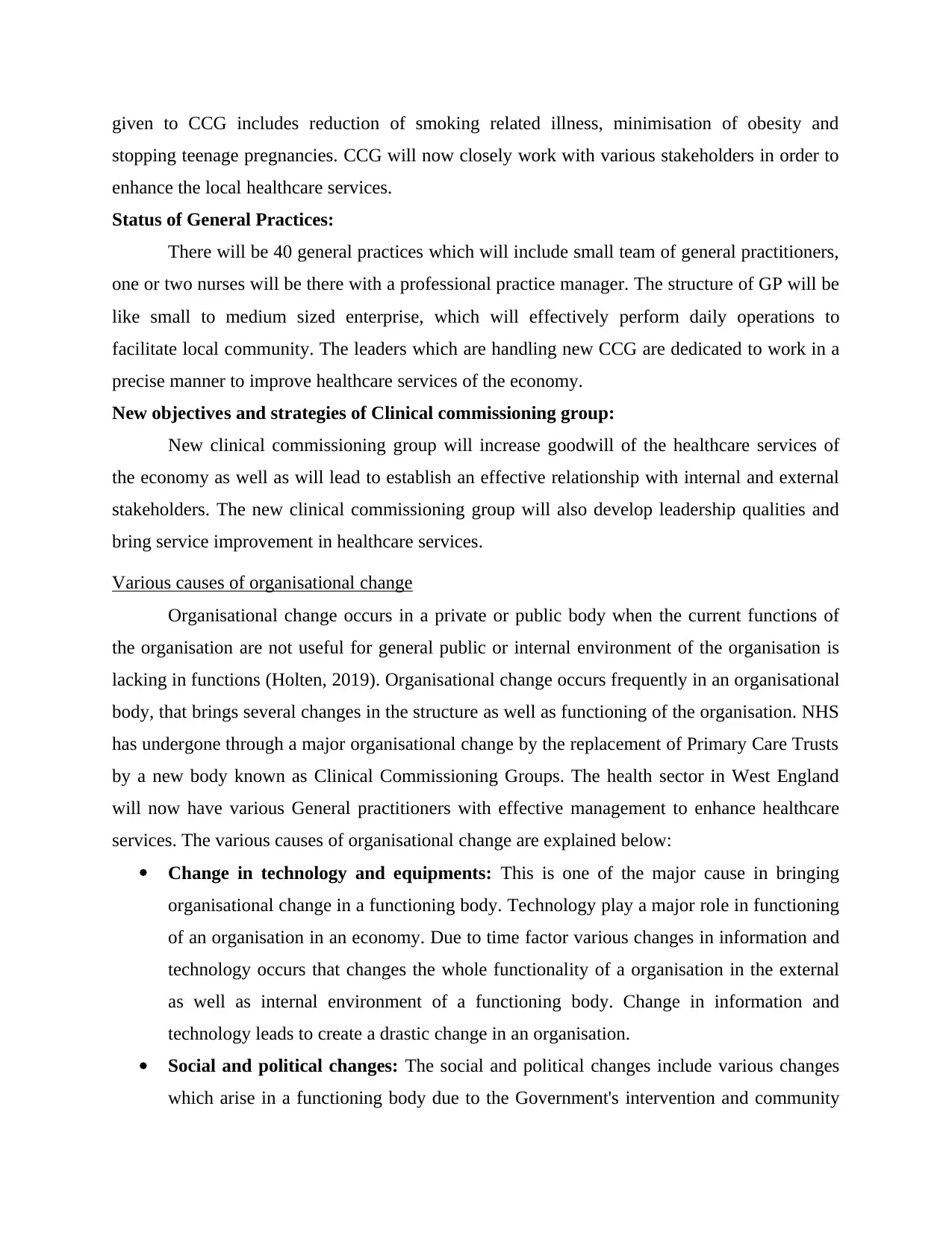
given to CCG includes reduction of smoking related illness, minimisation of obesity and
stopping teenage pregnancies. CCG will now closely work with various stakeholders in order to
enhance the local healthcare services.
Status of General Practices:
There will be 40 general practices which will include small team of general practitioners,
one or two nurses will be there with a professional practice manager. The structure of GP will be
like small to medium sized enterprise, which will effectively perform daily operations to
facilitate local community. The leaders which are handling new CCG are dedicated to work in a
precise manner to improve healthcare services of the economy.
New objectives and strategies of Clinical commissioning group:
New clinical commissioning group will increase goodwill of the healthcare services of
the economy as well as will lead to establish an effective relationship with internal and external
stakeholders. The new clinical commissioning group will also develop leadership qualities and
bring service improvement in healthcare services.
Various causes of organisational change
Organisational change occurs in a private or public body when the current functions of
the organisation are not useful for general public or internal environment of the organisation is
lacking in functions (Holten, 2019). Organisational change occurs frequently in an organisational
body, that brings several changes in the structure as well as functioning of the organisation. NHS
has undergone through a major organisational change by the replacement of Primary Care Trusts
by a new body known as Clinical Commissioning Groups. The health sector in West England
will now have various General practitioners with effective management to enhance healthcare
services. The various causes of organisational change are explained below:
Change in technology and equipments: This is one of the major cause in bringing
organisational change in a functioning body. Technology play a major role in functioning
of an organisation in an economy. Due to time factor various changes in information and
technology occurs that changes the whole functionality of a organisation in the external
as well as internal environment of a functioning body. Change in information and
technology leads to create a drastic change in an organisation.
Social and political changes: The social and political changes include various changes
which arise in a functioning body due to the Government's intervention and community
stopping teenage pregnancies. CCG will now closely work with various stakeholders in order to
enhance the local healthcare services.
Status of General Practices:
There will be 40 general practices which will include small team of general practitioners,
one or two nurses will be there with a professional practice manager. The structure of GP will be
like small to medium sized enterprise, which will effectively perform daily operations to
facilitate local community. The leaders which are handling new CCG are dedicated to work in a
precise manner to improve healthcare services of the economy.
New objectives and strategies of Clinical commissioning group:
New clinical commissioning group will increase goodwill of the healthcare services of
the economy as well as will lead to establish an effective relationship with internal and external
stakeholders. The new clinical commissioning group will also develop leadership qualities and
bring service improvement in healthcare services.
Various causes of organisational change
Organisational change occurs in a private or public body when the current functions of
the organisation are not useful for general public or internal environment of the organisation is
lacking in functions (Holten, 2019). Organisational change occurs frequently in an organisational
body, that brings several changes in the structure as well as functioning of the organisation. NHS
has undergone through a major organisational change by the replacement of Primary Care Trusts
by a new body known as Clinical Commissioning Groups. The health sector in West England
will now have various General practitioners with effective management to enhance healthcare
services. The various causes of organisational change are explained below:
Change in technology and equipments: This is one of the major cause in bringing
organisational change in a functioning body. Technology play a major role in functioning
of an organisation in an economy. Due to time factor various changes in information and
technology occurs that changes the whole functionality of a organisation in the external
as well as internal environment of a functioning body. Change in information and
technology leads to create a drastic change in an organisation.
Social and political changes: The social and political changes include various changes
which arise in a functioning body due to the Government's intervention and community
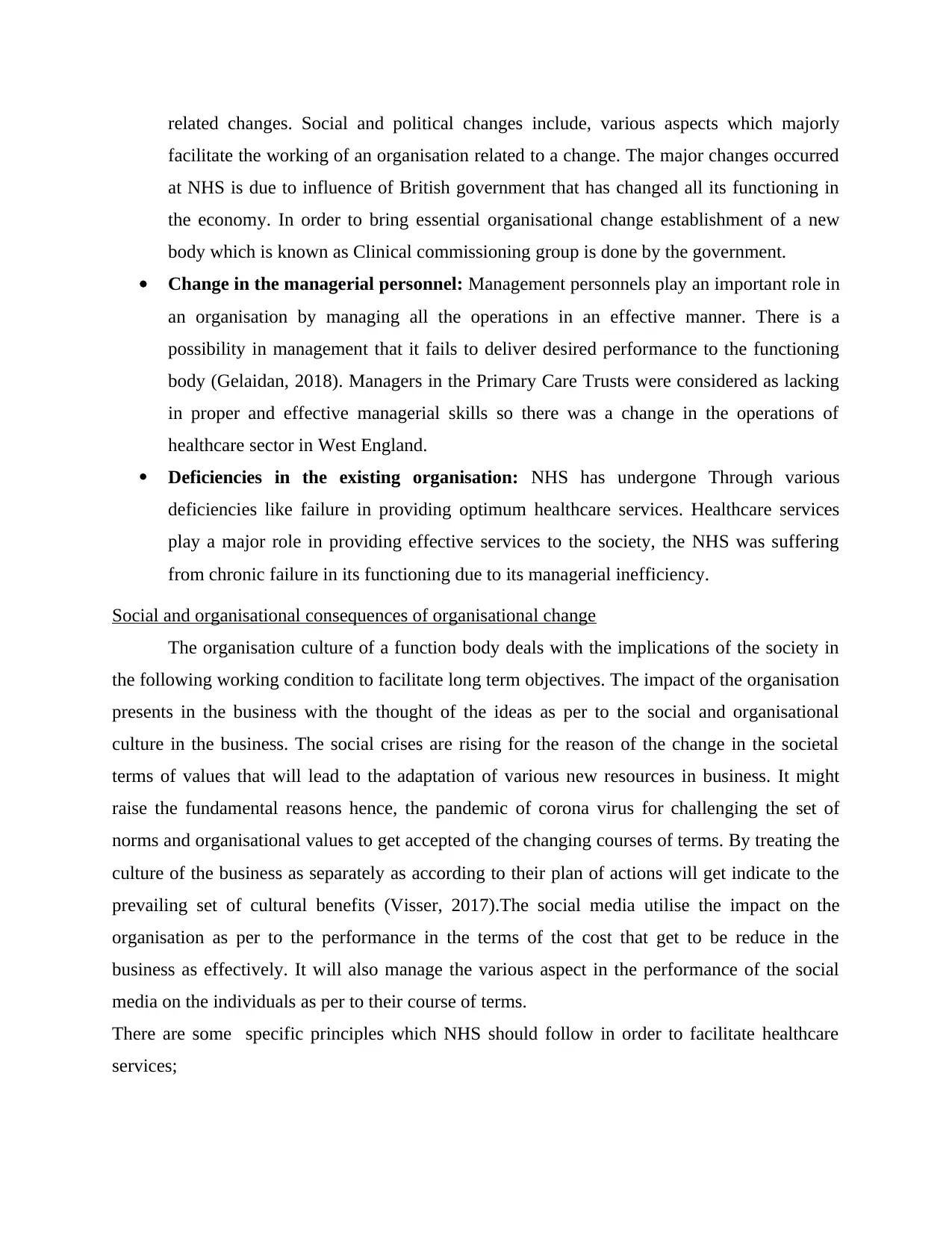
related changes. Social and political changes include, various aspects which majorly
facilitate the working of an organisation related to a change. The major changes occurred
at NHS is due to influence of British government that has changed all its functioning in
the economy. In order to bring essential organisational change establishment of a new
body which is known as Clinical commissioning group is done by the government.
Change in the managerial personnel: Management personnels play an important role in
an organisation by managing all the operations in an effective manner. There is a
possibility in management that it fails to deliver desired performance to the functioning
body (Gelaidan, 2018). Managers in the Primary Care Trusts were considered as lacking
in proper and effective managerial skills so there was a change in the operations of
healthcare sector in West England.
Deficiencies in the existing organisation: NHS has undergone Through various
deficiencies like failure in providing optimum healthcare services. Healthcare services
play a major role in providing effective services to the society, the NHS was suffering
from chronic failure in its functioning due to its managerial inefficiency.
Social and organisational consequences of organisational change
The organisation culture of a function body deals with the implications of the society in
the following working condition to facilitate long term objectives. The impact of the organisation
presents in the business with the thought of the ideas as per to the social and organisational
culture in the business. The social crises are rising for the reason of the change in the societal
terms of values that will lead to the adaptation of various new resources in business. It might
raise the fundamental reasons hence, the pandemic of corona virus for challenging the set of
norms and organisational values to get accepted of the changing courses of terms. By treating the
culture of the business as separately as according to their plan of actions will get indicate to the
prevailing set of cultural benefits (Visser, 2017).The social media utilise the impact on the
organisation as per to the performance in the terms of the cost that get to be reduce in the
business as effectively. It will also manage the various aspect in the performance of the social
media on the individuals as per to their course of terms.
There are some specific principles which NHS should follow in order to facilitate healthcare
services;
facilitate the working of an organisation related to a change. The major changes occurred
at NHS is due to influence of British government that has changed all its functioning in
the economy. In order to bring essential organisational change establishment of a new
body which is known as Clinical commissioning group is done by the government.
Change in the managerial personnel: Management personnels play an important role in
an organisation by managing all the operations in an effective manner. There is a
possibility in management that it fails to deliver desired performance to the functioning
body (Gelaidan, 2018). Managers in the Primary Care Trusts were considered as lacking
in proper and effective managerial skills so there was a change in the operations of
healthcare sector in West England.
Deficiencies in the existing organisation: NHS has undergone Through various
deficiencies like failure in providing optimum healthcare services. Healthcare services
play a major role in providing effective services to the society, the NHS was suffering
from chronic failure in its functioning due to its managerial inefficiency.
Social and organisational consequences of organisational change
The organisation culture of a function body deals with the implications of the society in
the following working condition to facilitate long term objectives. The impact of the organisation
presents in the business with the thought of the ideas as per to the social and organisational
culture in the business. The social crises are rising for the reason of the change in the societal
terms of values that will lead to the adaptation of various new resources in business. It might
raise the fundamental reasons hence, the pandemic of corona virus for challenging the set of
norms and organisational values to get accepted of the changing courses of terms. By treating the
culture of the business as separately as according to their plan of actions will get indicate to the
prevailing set of cultural benefits (Visser, 2017).The social media utilise the impact on the
organisation as per to the performance in the terms of the cost that get to be reduce in the
business as effectively. It will also manage the various aspect in the performance of the social
media on the individuals as per to their course of terms.
There are some specific principles which NHS should follow in order to facilitate healthcare
services;
⊘ This is a preview!⊘
Do you want full access?
Subscribe today to unlock all pages.

Trusted by 1+ million students worldwide
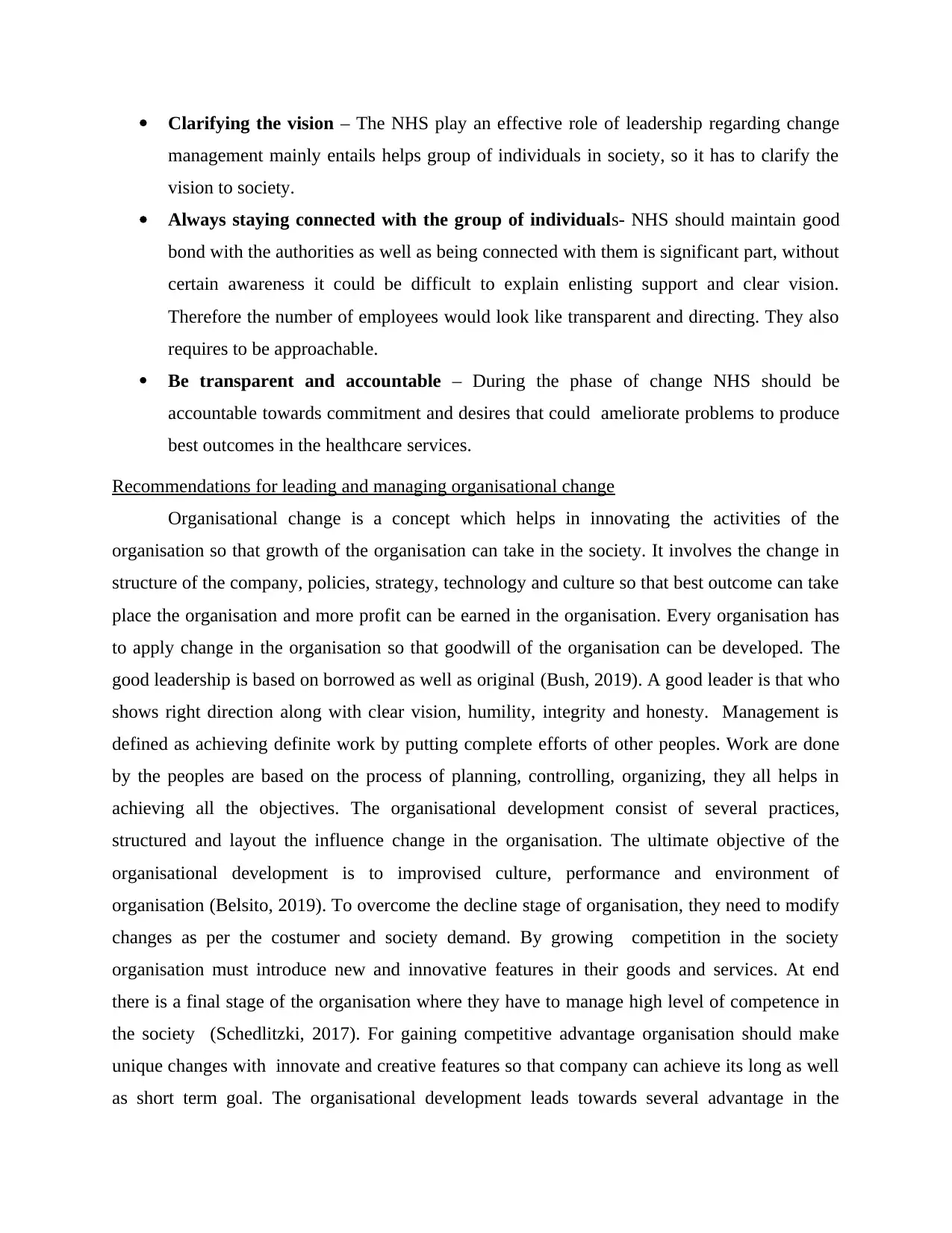
Clarifying the vision – The NHS play an effective role of leadership regarding change
management mainly entails helps group of individuals in society, so it has to clarify the
vision to society.
Always staying connected with the group of individuals- NHS should maintain good
bond with the authorities as well as being connected with them is significant part, without
certain awareness it could be difficult to explain enlisting support and clear vision.
Therefore the number of employees would look like transparent and directing. They also
requires to be approachable.
Be transparent and accountable – During the phase of change NHS should be
accountable towards commitment and desires that could ameliorate problems to produce
best outcomes in the healthcare services.
Recommendations for leading and managing organisational change
Organisational change is a concept which helps in innovating the activities of the
organisation so that growth of the organisation can take in the society. It involves the change in
structure of the company, policies, strategy, technology and culture so that best outcome can take
place the organisation and more profit can be earned in the organisation. Every organisation has
to apply change in the organisation so that goodwill of the organisation can be developed. The
good leadership is based on borrowed as well as original (Bush, 2019). A good leader is that who
shows right direction along with clear vision, humility, integrity and honesty. Management is
defined as achieving definite work by putting complete efforts of other peoples. Work are done
by the peoples are based on the process of planning, controlling, organizing, they all helps in
achieving all the objectives. The organisational development consist of several practices,
structured and layout the influence change in the organisation. The ultimate objective of the
organisational development is to improvised culture, performance and environment of
organisation (Belsito, 2019). To overcome the decline stage of organisation, they need to modify
changes as per the costumer and society demand. By growing competition in the society
organisation must introduce new and innovative features in their goods and services. At end
there is a final stage of the organisation where they have to manage high level of competence in
the society (Schedlitzki, 2017). For gaining competitive advantage organisation should make
unique changes with innovate and creative features so that company can achieve its long as well
as short term goal. The organisational development leads towards several advantage in the
management mainly entails helps group of individuals in society, so it has to clarify the
vision to society.
Always staying connected with the group of individuals- NHS should maintain good
bond with the authorities as well as being connected with them is significant part, without
certain awareness it could be difficult to explain enlisting support and clear vision.
Therefore the number of employees would look like transparent and directing. They also
requires to be approachable.
Be transparent and accountable – During the phase of change NHS should be
accountable towards commitment and desires that could ameliorate problems to produce
best outcomes in the healthcare services.
Recommendations for leading and managing organisational change
Organisational change is a concept which helps in innovating the activities of the
organisation so that growth of the organisation can take in the society. It involves the change in
structure of the company, policies, strategy, technology and culture so that best outcome can take
place the organisation and more profit can be earned in the organisation. Every organisation has
to apply change in the organisation so that goodwill of the organisation can be developed. The
good leadership is based on borrowed as well as original (Bush, 2019). A good leader is that who
shows right direction along with clear vision, humility, integrity and honesty. Management is
defined as achieving definite work by putting complete efforts of other peoples. Work are done
by the peoples are based on the process of planning, controlling, organizing, they all helps in
achieving all the objectives. The organisational development consist of several practices,
structured and layout the influence change in the organisation. The ultimate objective of the
organisational development is to improvised culture, performance and environment of
organisation (Belsito, 2019). To overcome the decline stage of organisation, they need to modify
changes as per the costumer and society demand. By growing competition in the society
organisation must introduce new and innovative features in their goods and services. At end
there is a final stage of the organisation where they have to manage high level of competence in
the society (Schedlitzki, 2017). For gaining competitive advantage organisation should make
unique changes with innovate and creative features so that company can achieve its long as well
as short term goal. The organisational development leads towards several advantage in the
Paraphrase This Document
Need a fresh take? Get an instant paraphrase of this document with our AI Paraphraser
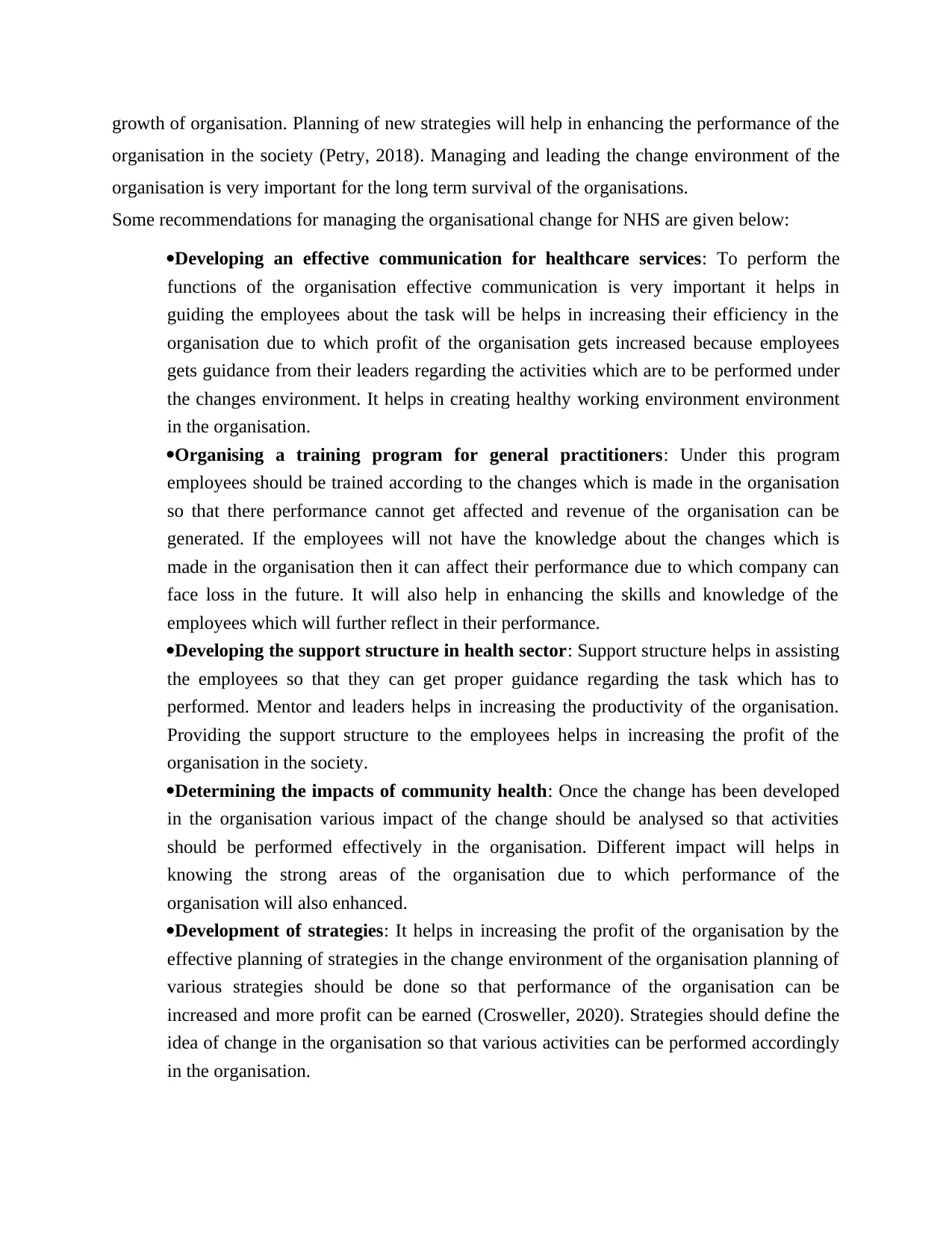
growth of organisation. Planning of new strategies will help in enhancing the performance of the
organisation in the society (Petry, 2018). Managing and leading the change environment of the
organisation is very important for the long term survival of the organisations.
Some recommendations for managing the organisational change for NHS are given below:
Developing an effective communication for healthcare services: To perform the
functions of the organisation effective communication is very important it helps in
guiding the employees about the task will be helps in increasing their efficiency in the
organisation due to which profit of the organisation gets increased because employees
gets guidance from their leaders regarding the activities which are to be performed under
the changes environment. It helps in creating healthy working environment environment
in the organisation.
Organising a training program for general practitioners: Under this program
employees should be trained according to the changes which is made in the organisation
so that there performance cannot get affected and revenue of the organisation can be
generated. If the employees will not have the knowledge about the changes which is
made in the organisation then it can affect their performance due to which company can
face loss in the future. It will also help in enhancing the skills and knowledge of the
employees which will further reflect in their performance.
Developing the support structure in health sector: Support structure helps in assisting
the employees so that they can get proper guidance regarding the task which has to
performed. Mentor and leaders helps in increasing the productivity of the organisation.
Providing the support structure to the employees helps in increasing the profit of the
organisation in the society.
Determining the impacts of community health: Once the change has been developed
in the organisation various impact of the change should be analysed so that activities
should be performed effectively in the organisation. Different impact will helps in
knowing the strong areas of the organisation due to which performance of the
organisation will also enhanced.
Development of strategies: It helps in increasing the profit of the organisation by the
effective planning of strategies in the change environment of the organisation planning of
various strategies should be done so that performance of the organisation can be
increased and more profit can be earned (Crosweller, 2020). Strategies should define the
idea of change in the organisation so that various activities can be performed accordingly
in the organisation.
organisation in the society (Petry, 2018). Managing and leading the change environment of the
organisation is very important for the long term survival of the organisations.
Some recommendations for managing the organisational change for NHS are given below:
Developing an effective communication for healthcare services: To perform the
functions of the organisation effective communication is very important it helps in
guiding the employees about the task will be helps in increasing their efficiency in the
organisation due to which profit of the organisation gets increased because employees
gets guidance from their leaders regarding the activities which are to be performed under
the changes environment. It helps in creating healthy working environment environment
in the organisation.
Organising a training program for general practitioners: Under this program
employees should be trained according to the changes which is made in the organisation
so that there performance cannot get affected and revenue of the organisation can be
generated. If the employees will not have the knowledge about the changes which is
made in the organisation then it can affect their performance due to which company can
face loss in the future. It will also help in enhancing the skills and knowledge of the
employees which will further reflect in their performance.
Developing the support structure in health sector: Support structure helps in assisting
the employees so that they can get proper guidance regarding the task which has to
performed. Mentor and leaders helps in increasing the productivity of the organisation.
Providing the support structure to the employees helps in increasing the profit of the
organisation in the society.
Determining the impacts of community health: Once the change has been developed
in the organisation various impact of the change should be analysed so that activities
should be performed effectively in the organisation. Different impact will helps in
knowing the strong areas of the organisation due to which performance of the
organisation will also enhanced.
Development of strategies: It helps in increasing the profit of the organisation by the
effective planning of strategies in the change environment of the organisation planning of
various strategies should be done so that performance of the organisation can be
increased and more profit can be earned (Crosweller, 2020). Strategies should define the
idea of change in the organisation so that various activities can be performed accordingly
in the organisation.
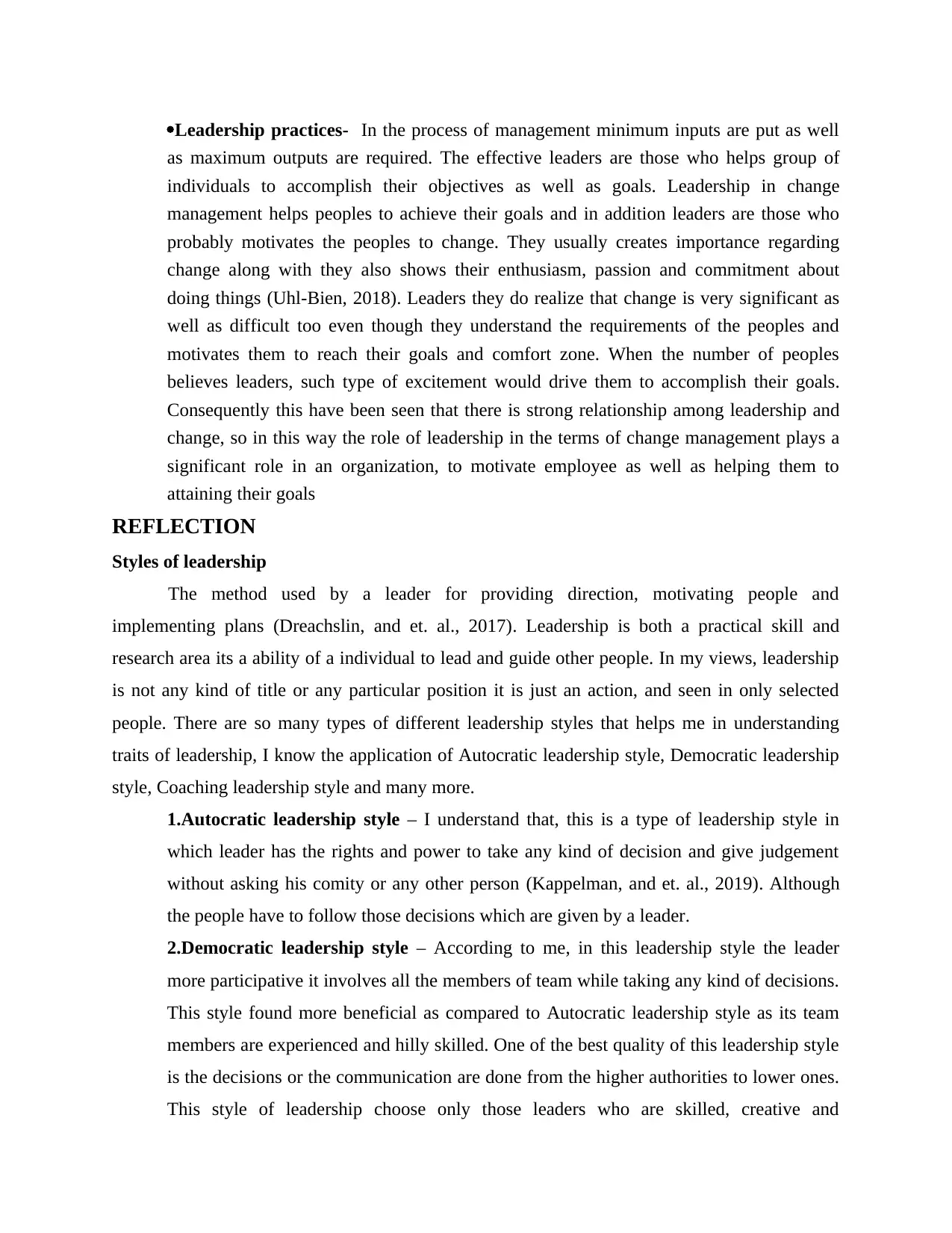
Leadership practices- In the process of management minimum inputs are put as well
as maximum outputs are required. The effective leaders are those who helps group of
individuals to accomplish their objectives as well as goals. Leadership in change
management helps peoples to achieve their goals and in addition leaders are those who
probably motivates the peoples to change. They usually creates importance regarding
change along with they also shows their enthusiasm, passion and commitment about
doing things (Uhl-Bien, 2018). Leaders they do realize that change is very significant as
well as difficult too even though they understand the requirements of the peoples and
motivates them to reach their goals and comfort zone. When the number of peoples
believes leaders, such type of excitement would drive them to accomplish their goals.
Consequently this have been seen that there is strong relationship among leadership and
change, so in this way the role of leadership in the terms of change management plays a
significant role in an organization, to motivate employee as well as helping them to
attaining their goals
REFLECTION
Styles of leadership
The method used by a leader for providing direction, motivating people and
implementing plans (Dreachslin, and et. al., 2017). Leadership is both a practical skill and
research area its a ability of a individual to lead and guide other people. In my views, leadership
is not any kind of title or any particular position it is just an action, and seen in only selected
people. There are so many types of different leadership styles that helps me in understanding
traits of leadership, I know the application of Autocratic leadership style, Democratic leadership
style, Coaching leadership style and many more.
1.Autocratic leadership style – I understand that, this is a type of leadership style in
which leader has the rights and power to take any kind of decision and give judgement
without asking his comity or any other person (Kappelman, and et. al., 2019). Although
the people have to follow those decisions which are given by a leader.
2.Democratic leadership style – According to me, in this leadership style the leader
more participative it involves all the members of team while taking any kind of decisions.
This style found more beneficial as compared to Autocratic leadership style as its team
members are experienced and hilly skilled. One of the best quality of this leadership style
is the decisions or the communication are done from the higher authorities to lower ones.
This style of leadership choose only those leaders who are skilled, creative and
as maximum outputs are required. The effective leaders are those who helps group of
individuals to accomplish their objectives as well as goals. Leadership in change
management helps peoples to achieve their goals and in addition leaders are those who
probably motivates the peoples to change. They usually creates importance regarding
change along with they also shows their enthusiasm, passion and commitment about
doing things (Uhl-Bien, 2018). Leaders they do realize that change is very significant as
well as difficult too even though they understand the requirements of the peoples and
motivates them to reach their goals and comfort zone. When the number of peoples
believes leaders, such type of excitement would drive them to accomplish their goals.
Consequently this have been seen that there is strong relationship among leadership and
change, so in this way the role of leadership in the terms of change management plays a
significant role in an organization, to motivate employee as well as helping them to
attaining their goals
REFLECTION
Styles of leadership
The method used by a leader for providing direction, motivating people and
implementing plans (Dreachslin, and et. al., 2017). Leadership is both a practical skill and
research area its a ability of a individual to lead and guide other people. In my views, leadership
is not any kind of title or any particular position it is just an action, and seen in only selected
people. There are so many types of different leadership styles that helps me in understanding
traits of leadership, I know the application of Autocratic leadership style, Democratic leadership
style, Coaching leadership style and many more.
1.Autocratic leadership style – I understand that, this is a type of leadership style in
which leader has the rights and power to take any kind of decision and give judgement
without asking his comity or any other person (Kappelman, and et. al., 2019). Although
the people have to follow those decisions which are given by a leader.
2.Democratic leadership style – According to me, in this leadership style the leader
more participative it involves all the members of team while taking any kind of decisions.
This style found more beneficial as compared to Autocratic leadership style as its team
members are experienced and hilly skilled. One of the best quality of this leadership style
is the decisions or the communication are done from the higher authorities to lower ones.
This style of leadership choose only those leaders who are skilled, creative and
⊘ This is a preview!⊘
Do you want full access?
Subscribe today to unlock all pages.

Trusted by 1+ million students worldwide
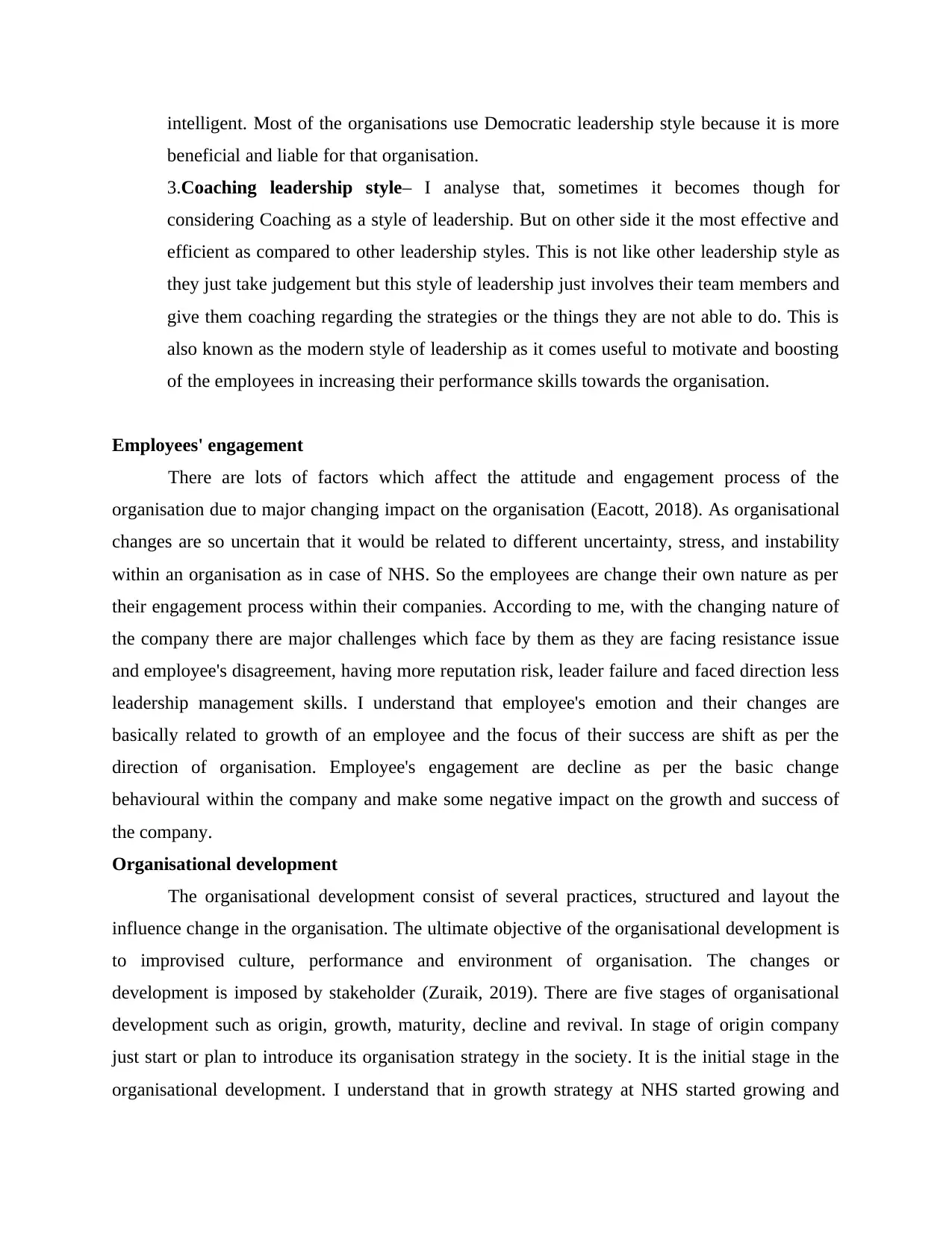
intelligent. Most of the organisations use Democratic leadership style because it is more
beneficial and liable for that organisation.
3.Coaching leadership style– I analyse that, sometimes it becomes though for
considering Coaching as a style of leadership. But on other side it the most effective and
efficient as compared to other leadership styles. This is not like other leadership style as
they just take judgement but this style of leadership just involves their team members and
give them coaching regarding the strategies or the things they are not able to do. This is
also known as the modern style of leadership as it comes useful to motivate and boosting
of the employees in increasing their performance skills towards the organisation.
Employees' engagement
There are lots of factors which affect the attitude and engagement process of the
organisation due to major changing impact on the organisation (Eacott, 2018). As organisational
changes are so uncertain that it would be related to different uncertainty, stress, and instability
within an organisation as in case of NHS. So the employees are change their own nature as per
their engagement process within their companies. According to me, with the changing nature of
the company there are major challenges which face by them as they are facing resistance issue
and employee's disagreement, having more reputation risk, leader failure and faced direction less
leadership management skills. I understand that employee's emotion and their changes are
basically related to growth of an employee and the focus of their success are shift as per the
direction of organisation. Employee's engagement are decline as per the basic change
behavioural within the company and make some negative impact on the growth and success of
the company.
Organisational development
The organisational development consist of several practices, structured and layout the
influence change in the organisation. The ultimate objective of the organisational development is
to improvised culture, performance and environment of organisation. The changes or
development is imposed by stakeholder (Zuraik, 2019). There are five stages of organisational
development such as origin, growth, maturity, decline and revival. In stage of origin company
just start or plan to introduce its organisation strategy in the society. It is the initial stage in the
organisational development. I understand that in growth strategy at NHS started growing and
beneficial and liable for that organisation.
3.Coaching leadership style– I analyse that, sometimes it becomes though for
considering Coaching as a style of leadership. But on other side it the most effective and
efficient as compared to other leadership styles. This is not like other leadership style as
they just take judgement but this style of leadership just involves their team members and
give them coaching regarding the strategies or the things they are not able to do. This is
also known as the modern style of leadership as it comes useful to motivate and boosting
of the employees in increasing their performance skills towards the organisation.
Employees' engagement
There are lots of factors which affect the attitude and engagement process of the
organisation due to major changing impact on the organisation (Eacott, 2018). As organisational
changes are so uncertain that it would be related to different uncertainty, stress, and instability
within an organisation as in case of NHS. So the employees are change their own nature as per
their engagement process within their companies. According to me, with the changing nature of
the company there are major challenges which face by them as they are facing resistance issue
and employee's disagreement, having more reputation risk, leader failure and faced direction less
leadership management skills. I understand that employee's emotion and their changes are
basically related to growth of an employee and the focus of their success are shift as per the
direction of organisation. Employee's engagement are decline as per the basic change
behavioural within the company and make some negative impact on the growth and success of
the company.
Organisational development
The organisational development consist of several practices, structured and layout the
influence change in the organisation. The ultimate objective of the organisational development is
to improvised culture, performance and environment of organisation. The changes or
development is imposed by stakeholder (Zuraik, 2019). There are five stages of organisational
development such as origin, growth, maturity, decline and revival. In stage of origin company
just start or plan to introduce its organisation strategy in the society. It is the initial stage in the
organisational development. I understand that in growth strategy at NHS started growing and
Paraphrase This Document
Need a fresh take? Get an instant paraphrase of this document with our AI Paraphraser

expanding its organisation operation in society. In stage of maturity, organisation reach and
achieve at top of the society. At this stage organisational accomplished all the aims of
organisation and received success at each sector or segment. After that decline stage occurs in
the life cycle of organisational development. The goods and services goes decline position as the
company is not introducing any change or innovative as well as creativity in existing goods and
services. To overcome the decline stage of organisation, they need to modify changes as per the
costumer and society demand. According to me, by growing competition at NHS in the society
organisation must introduce new and innovative features in their goods and services. At end
there is a final stage of the organisation where they have to manage high level of competence in
the society (Jin, 2017) For gaining competitive advantage organisation should make unique
changes with innovate and creative features so that company can achieve its long as well as
short term goal. The organisational development leads towards several advantage in the growth
of organisation. The continuous improvement take place occurs in respect of organisational
development. This will facilitate effective communication in the organisation that understand
needs or wants of consumer and workforce (Ellis, 2018).. The overall productivity,value and
enhancement of employee performance occur to contribute success and growth of the company.
CONCLUSION
As per discussed above Leadership in the terms of change management is defined as an
art which helps encourage and motivates group of peoples to reach their objectives as well as
goals, along with motivating them to accomplish their comfort zone. Leaders always shows right
direction to the people with clear vision and helps them to attain their goals. They shows their
passionate, commitment towards the change. Leadership is very significant for every
organization, because the quality of leadership motivates and encourage employees thus in this
way the role of leadership in the terms of change management is very essential.
achieve at top of the society. At this stage organisational accomplished all the aims of
organisation and received success at each sector or segment. After that decline stage occurs in
the life cycle of organisational development. The goods and services goes decline position as the
company is not introducing any change or innovative as well as creativity in existing goods and
services. To overcome the decline stage of organisation, they need to modify changes as per the
costumer and society demand. According to me, by growing competition at NHS in the society
organisation must introduce new and innovative features in their goods and services. At end
there is a final stage of the organisation where they have to manage high level of competence in
the society (Jin, 2017) For gaining competitive advantage organisation should make unique
changes with innovate and creative features so that company can achieve its long as well as
short term goal. The organisational development leads towards several advantage in the growth
of organisation. The continuous improvement take place occurs in respect of organisational
development. This will facilitate effective communication in the organisation that understand
needs or wants of consumer and workforce (Ellis, 2018).. The overall productivity,value and
enhancement of employee performance occur to contribute success and growth of the company.
CONCLUSION
As per discussed above Leadership in the terms of change management is defined as an
art which helps encourage and motivates group of peoples to reach their objectives as well as
goals, along with motivating them to accomplish their comfort zone. Leaders always shows right
direction to the people with clear vision and helps them to attain their goals. They shows their
passionate, commitment towards the change. Leadership is very significant for every
organization, because the quality of leadership motivates and encourage employees thus in this
way the role of leadership in the terms of change management is very essential.
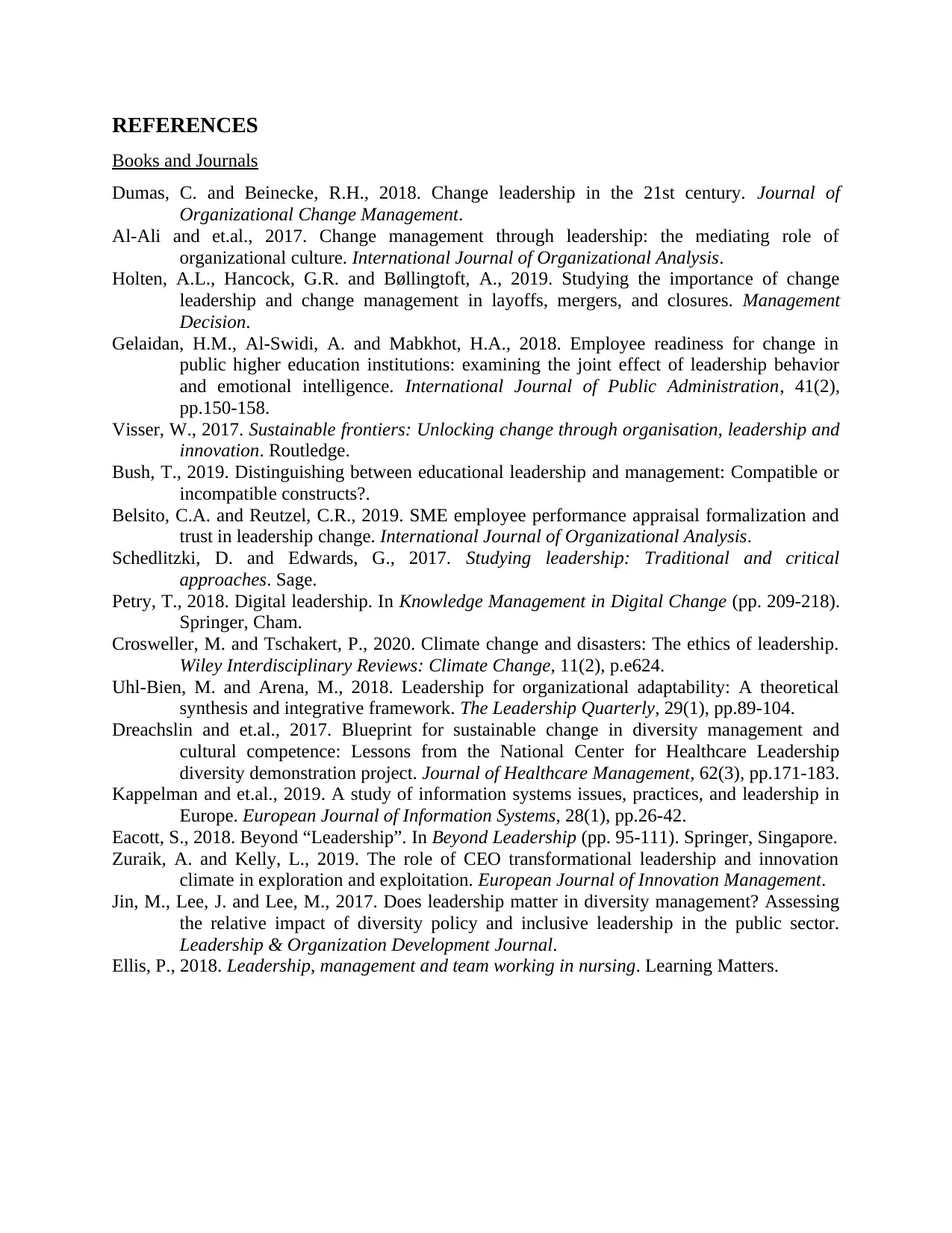
REFERENCES
Books and Journals
Dumas, C. and Beinecke, R.H., 2018. Change leadership in the 21st century. Journal of
Organizational Change Management.
Al-Ali and et.al., 2017. Change management through leadership: the mediating role of
organizational culture. International Journal of Organizational Analysis.
Holten, A.L., Hancock, G.R. and Bøllingtoft, A., 2019. Studying the importance of change
leadership and change management in layoffs, mergers, and closures. Management
Decision.
Gelaidan, H.M., Al-Swidi, A. and Mabkhot, H.A., 2018. Employee readiness for change in
public higher education institutions: examining the joint effect of leadership behavior
and emotional intelligence. International Journal of Public Administration, 41(2),
pp.150-158.
Visser, W., 2017. Sustainable frontiers: Unlocking change through organisation, leadership and
innovation. Routledge.
Bush, T., 2019. Distinguishing between educational leadership and management: Compatible or
incompatible constructs?.
Belsito, C.A. and Reutzel, C.R., 2019. SME employee performance appraisal formalization and
trust in leadership change. International Journal of Organizational Analysis.
Schedlitzki, D. and Edwards, G., 2017. Studying leadership: Traditional and critical
approaches. Sage.
Petry, T., 2018. Digital leadership. In Knowledge Management in Digital Change (pp. 209-218).
Springer, Cham.
Crosweller, M. and Tschakert, P., 2020. Climate change and disasters: The ethics of leadership.
Wiley Interdisciplinary Reviews: Climate Change, 11(2), p.e624.
Uhl-Bien, M. and Arena, M., 2018. Leadership for organizational adaptability: A theoretical
synthesis and integrative framework. The Leadership Quarterly, 29(1), pp.89-104.
Dreachslin and et.al., 2017. Blueprint for sustainable change in diversity management and
cultural competence: Lessons from the National Center for Healthcare Leadership
diversity demonstration project. Journal of Healthcare Management, 62(3), pp.171-183.
Kappelman and et.al., 2019. A study of information systems issues, practices, and leadership in
Europe. European Journal of Information Systems, 28(1), pp.26-42.
Eacott, S., 2018. Beyond “Leadership”. In Beyond Leadership (pp. 95-111). Springer, Singapore.
Zuraik, A. and Kelly, L., 2019. The role of CEO transformational leadership and innovation
climate in exploration and exploitation. European Journal of Innovation Management.
Jin, M., Lee, J. and Lee, M., 2017. Does leadership matter in diversity management? Assessing
the relative impact of diversity policy and inclusive leadership in the public sector.
Leadership & Organization Development Journal.
Ellis, P., 2018. Leadership, management and team working in nursing. Learning Matters.
Books and Journals
Dumas, C. and Beinecke, R.H., 2018. Change leadership in the 21st century. Journal of
Organizational Change Management.
Al-Ali and et.al., 2017. Change management through leadership: the mediating role of
organizational culture. International Journal of Organizational Analysis.
Holten, A.L., Hancock, G.R. and Bøllingtoft, A., 2019. Studying the importance of change
leadership and change management in layoffs, mergers, and closures. Management
Decision.
Gelaidan, H.M., Al-Swidi, A. and Mabkhot, H.A., 2018. Employee readiness for change in
public higher education institutions: examining the joint effect of leadership behavior
and emotional intelligence. International Journal of Public Administration, 41(2),
pp.150-158.
Visser, W., 2017. Sustainable frontiers: Unlocking change through organisation, leadership and
innovation. Routledge.
Bush, T., 2019. Distinguishing between educational leadership and management: Compatible or
incompatible constructs?.
Belsito, C.A. and Reutzel, C.R., 2019. SME employee performance appraisal formalization and
trust in leadership change. International Journal of Organizational Analysis.
Schedlitzki, D. and Edwards, G., 2017. Studying leadership: Traditional and critical
approaches. Sage.
Petry, T., 2018. Digital leadership. In Knowledge Management in Digital Change (pp. 209-218).
Springer, Cham.
Crosweller, M. and Tschakert, P., 2020. Climate change and disasters: The ethics of leadership.
Wiley Interdisciplinary Reviews: Climate Change, 11(2), p.e624.
Uhl-Bien, M. and Arena, M., 2018. Leadership for organizational adaptability: A theoretical
synthesis and integrative framework. The Leadership Quarterly, 29(1), pp.89-104.
Dreachslin and et.al., 2017. Blueprint for sustainable change in diversity management and
cultural competence: Lessons from the National Center for Healthcare Leadership
diversity demonstration project. Journal of Healthcare Management, 62(3), pp.171-183.
Kappelman and et.al., 2019. A study of information systems issues, practices, and leadership in
Europe. European Journal of Information Systems, 28(1), pp.26-42.
Eacott, S., 2018. Beyond “Leadership”. In Beyond Leadership (pp. 95-111). Springer, Singapore.
Zuraik, A. and Kelly, L., 2019. The role of CEO transformational leadership and innovation
climate in exploration and exploitation. European Journal of Innovation Management.
Jin, M., Lee, J. and Lee, M., 2017. Does leadership matter in diversity management? Assessing
the relative impact of diversity policy and inclusive leadership in the public sector.
Leadership & Organization Development Journal.
Ellis, P., 2018. Leadership, management and team working in nursing. Learning Matters.
⊘ This is a preview!⊘
Do you want full access?
Subscribe today to unlock all pages.

Trusted by 1+ million students worldwide
1 out of 14
Related Documents
Your All-in-One AI-Powered Toolkit for Academic Success.
+13062052269
info@desklib.com
Available 24*7 on WhatsApp / Email
![[object Object]](/_next/static/media/star-bottom.7253800d.svg)
Unlock your academic potential
Copyright © 2020–2025 A2Z Services. All Rights Reserved. Developed and managed by ZUCOL.




